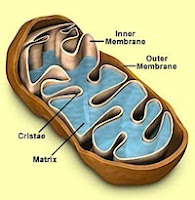While not quite as bad as it once was, the reality is that most people have never heard of Mitochondrial Disease, and we have heard the phrase, “Mito what??” more times than we can count. Beyond the possibility of maybe hearing the term on a show that’s tracing the maternal lineage of some long passed pharaoh, there isn’t much reason that the average person would have ever heard the term. For a time, other than a brief explanation of them being the “powerhouses of the cell", most medical students didn’t know much more than that. Times have changed, and at least the medical world is learning a bit more, and understanding better what these diseases can do.
So what is Mitochondrial Disease?
I have, over the years, come up with the easiest, most simplified explanation for most people asking this question…..We have Mitochondria in every cell of our body, except for our red blood cells. It is within these mitochondria that the food we eat, and the oxygen that we breath is converted into a chemical the cells can use for energy. When there is a defect in this function, not enough energy is able to be produced and organ systems begin to fail.
Short and sweet huh!!??
What this means in real terms is that there are, at best, mini-brown out’s going on through out the kids bodies, most of the time…..and at worst, total black out’s are happening. When one system is stressed there is a cascade of stress that extends out to all the other systems. The body needs energy…..the body HAS TO HAVE energy to function. When energy is depleted, whole organ systems begin to malfunction.
To give you a more "scientific explanation", this picture shows the basic structure of the mitochondria that are present in every one of our cells.
Mitochondria are the powerhouses of the human cell; they convert the energy stored in sugars and fats into adenosine triphosphate (ATP), the essential energy molecule of all animals. This energy production is carried out on a complex folded inner membrane of the mitochondria. Every muscle cell is filled with mitochondria, combining sugars or fats with oxygen to yield water and ATP. Without this ATP, we would die, having no "power" left. Mitochondrial cytopathies have a diverse range of symptoms, and span all organ systems.
Each cell in our body has potentially hundreds of mitochondria, mostly dependent on the amount of energy that particular organ system requires to work efficiently. As new mitochondria are produced, some or all can be defective. At such point that the defective mitochondria outnumber the healthy ones, symptoms are most likely to appear.
There is such a large number of biochemical and genetic defects that currently a predictable clinical course does not exist. While once thought to always be progressive, as more mild versions of Mitochondrial Disease are being diagnosed, some are finding stability for long periods of time, while others have a more progressive course. Furthermore, it can affect even those within the same family very differently, and to different severities.
The one thing that can be said about the predictability of Mitochondrial Disease, is that there is NOTHING predictable about it.
Before the mid-twentieth century, little was known about mitochondrial disorders. The first diagnosis of a mitochondrial disorder occurred in 1959, and the genetic material of mitochondria, called mtDNA, was discovered in 1963. In the 1970s and 1980s, as more was learned about the mitochondria and more mitochondrial disorders were discovered, the term "mitochondrial myopathies" (myopathy meaning a disease of muscle tissue) was coined to describe the group of diseases. Further research in the 1990s led to classification of mitochondrial disorders. As it became evident that tissues other than muscle could be affected by mitochondrial defects, the term "mitochondrial cytopathies" (cytopathy meaning cell disorder) was adopted.
Credit for the above paragraph to www.healthline.com/galecontent/mitochondrial-disorders
Mitochondria are unique in that they have their own DNA, separate from the Nuclear DNA we are all most familiar with. The mtDNA are only passed on through the mother, and are passed on 100% of the time.
Genetically, the current prevailing wisdom is that 80-90% of Mitochondrial Disease is caused by a mutation on the Nuclear DNA, which translates into the pattern of inheritance (Mendelian) most are familiar with. This leaves 10-20% that are caused by a defect on the Mitochondrial DNA, which translates into Maternal Inheritance.
When to suspect Mitochondrial Disease?
Here are some "Rules of Thumb" of when to think mitochondrial disease:
1.A "common disease" (i.e. autism, cerebral palsy, lots of others) has atypical features that set it apart from the pack.
2.Three or more organ systems are involved.
3.Recurrent setbacks or flares in a chronic disease occur with infections.
Credit for above "rules of thumb" to Mitochondrial News, Spring 2000 Issue by Dr. Robert K. Navaiaux.
Problems That May Be Associated with Mitochondrial Cytopathies
| Organ Systems | Possible Problems |
| Brain | developmental delays, mental retardation, dementia, seizures, neuro-psychiatric disturbances, atypical cerebral palsy, migraines, strokes |
| Nerves | weakness (which may be intermittent), neuropathic pain, absent reflexes, dysautonomia, gastrointestinal problems (ge reflux, dysmotility, diarrhea, irritable bowel syndrome, constipation, pseudo-obstruction), fainting, absent or excessive sweating resulting in temperature regulation problems |
| Muscles | weakness, hypotonia, cramping, muscle pain |
| Kidneys | renal tubular acidosis or wasting resulting in loss of protein, magnesium, phosphorous, calcium and other electrolytes. |
| Heart | cardiac conduction defects (heart blocks), cardiomyopathy |
| Liver | hypoglycemia (low blood sugar), liver failure |
| Eyes | visual loss and blindness |
| Ears | hearing loss and deafness |
| Pancreas and Other Glands | diabetes and exocrine pancreatic failure (inability to make digestive enzymes), parathyroid failure (low calcium) |
| Systemic | failure to gain weight, short stature, fatigue, respiratory problems including intermittent air hunger, vomitting |
Taken from Mitochondrial News, Fall 1997 Issue by Bruce H. Cohen, M.D.
Resources
The United Mitochondrial Disease Foundation, or UMDF

